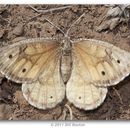pt-BR
nomes no trilho de navegação


Oeneis alberta, the Alberta Arctic, is a butterfly of the family Nymphalidae. It is found from the Canadian prairie provinces east to southern Manitoba. Isolated populations are found along the Rocky Mountains in Colorado, New Mexico and Arizona.[2]
The wingspan is 35–57 mm. The upperside is light yellow grey while the underside is light brown. Adults are on wing from May to June in one generation per year.
The larvae feed on bunch grass, possibly Festuca species. The species overwinters in the larval stage.
Oeneis alberta, the Alberta Arctic, is a butterfly of the family Nymphalidae. It is found from the Canadian prairie provinces east to southern Manitoba. Isolated populations are found along the Rocky Mountains in Colorado, New Mexico and Arizona.
The wingspan is 35–57 mm. The upperside is light yellow grey while the underside is light brown. Adults are on wing from May to June in one generation per year.
The larvae feed on bunch grass, possibly Festuca species. The species overwinters in the larval stage.
Oeneis alberta est une espèce d'insectes lépidoptères (papillons) appartenant à la famille des Nymphalidae à la sous-famille des Satyrinae et au genre Oeneis.
Oeneis alberta a été nommée par Henry John Elwes en 1893[1].
Oeneis alberta se nomme Alberta Arctic en anglais[1].
Oeneis alberta est de couleur marron jaunâtre. L'aile antérieure de couleur unie porte une ligne submarginale de quatre ocelles marron parfois pupillés. L'aile postérieure, un peu marbrée ne présente que deux ocelles plus petits.
Le revers des antérieures est semblable, celui des postérieures est striée de marron ce qui forme une alternance de bandes plus foncées et plus claires[2],[3].
La chenille de couleur marron est ornée d'une bande noire sur le dos et de bandes verdâtres sur les flancs[2].
Oeneis alberta vole en une génération en mai et juin[3].
Oeneis alberta hiverne au stade de chenille mature[2].
Les plantes hôtes sont des Poaceae et des Festuca[1].
Il est présent dans le nord-ouest de l'Amérique du Nord au Canada au Manitoba, Saskatchewan, en Alberta et Colombie-Britannique aux USA dans les états du Montana, Dakota du Nord et sous forme d'isolats dans le Wyoming, le Colorado, l'Arizona et le Nouveau-Mexique[3],[4].
Il réside dans des prairies.
Pas de statut de protection particulier[4].
Oeneis alberta est une espèce d'insectes lépidoptères (papillons) appartenant à la famille des Nymphalidae à la sous-famille des Satyrinae et au genre Oeneis.
Oeneis alberta is een vlinder uit de onderfamilie Satyrinae van de familie Nymphalidae.[1] De wetenschappelijke naam van de soort is voor het eerst geldig gepubliceerd in 1893 door Elwes.
Bronnen, noten en/of referenties